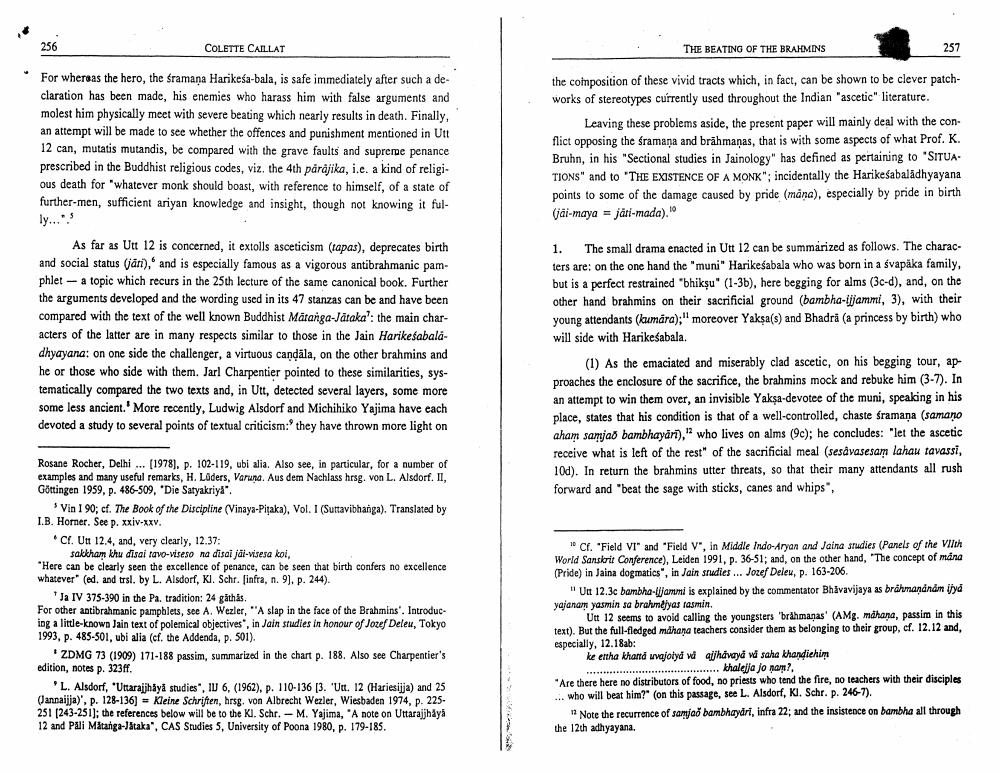________________
COLETTE CAILLAT
THE BEATING OF THE BRAHMINS
257
For whereas the hero, the framana Harikeśa-bala, is safe immediately after such a declaration has been made, his enemies who harass him with false arguments and molest him physically meet with severe beating which nearly results in death. Finally, an attempt will be made to see whether the offences and punishment mentioned in Utt 12 can, mutatis mutandis, be compared with the grave faults and supreme penance prescribed in the Buddhist religious codes, viz. the 4th părăjika, i.e. a kind of religious death for whatever monk should boast, with reference to himself, of a state of further-men, sufficient ariyan knowledge and insight, though not knowing it ful
the coinposition of these vivid tracts which, in fact, can be shown to be clever patchworks of stereotypes currently used throughout the Indian "ascetic" literature.
Leaving these problems aside, the present paper will mainly deal with the con flict opposing the framaņa and brähmaņas, that is with some aspects of what Prof. K. Bruhn, in his "Sectional studies in Jainology" has defined as pertaining to "SITUATIONS" and to 'THE EXISTENCE OF A MONK"; incidentally the Harikesabaladhyayana points to some of the damage caused by pride (mana), especially by pride in birth (jai-maya = jari-mada).
ly....5
As far as Utt 12 is concerned, it extolls asceticism (tapas), deprecates birth and social status (jari), and is especially famous as a vigorous antibrahmanic pamphlet - a topic which recurs in the 25th lecture of the same canonical book. Further the arguments developed and the wording used in its 47 stanzas can be and have been compared with the text of the well known Buddhist Matanga-Jataka': the main characters of the latter are in many respects similar to those in the Jain Harikesabaladhyayana: on one side the challenger, a virtuous candála, on the other brahmins and he or those who side with them. Jarl Charpentier pointed to these similarities, systematically compared the two texts and, in Utt, detected several layers, some more some less ancient. More recently, Ludwig Alsdorf and Michihiko Yajima have each devoted a study to several points of textual criticism: they have thrown more light on
1. The small drama enacted in Utt 12 can be summarized as follows. The characters are on the one hand the "muni" Harikeśabala who was born in a svapaka family, but is a perfect restrained "bhikṣu' (1-3b), here begging for alms (3c-d), and, on the other hand brahmins on their sacrificial ground (bambha-lijammi, 3), with their young attendants (kumara);" moreover Yaksa(s) and Bhadra (a princess by birth) who will side with Harikesabala.
(1) As the emaciated and miserably clad ascetic, on his begging tour, approaches the enclosure of the sacrifice, the brahmins mock and rebuke him (3-7). In an attempt to win them over, an invisible Yakşa-devotee of the muni, speaking in his place, states that his condition is that of a well-controlled, chaste framana (samano aham sanjao bambhayari)," who lives on alms (9c); he concludes: "let the ascetic receive what is left of the rest of the sacrificial meal (seså vasesam lahau tavassi, 10d). In return the brahmins utter threats, so that their many attendants all rush forward and "beat the sage with sticks, canes and whips
Rosane Rocher, Delhi ... (1978), p. 102-119. ubi alia. Also see, in particular, for a number of examples and many useful remarks, H. Lüders, Varuna, Aus dem Nachlass hrsg. von L. Alsdorf. II, Göttingen 1959, p. 486-509, "Die Satyakriya".
Vin 1 90; cf. The Book of the Discipline (Vinaya-Pisaka), Vol. 1 (Suttavibhanga). Translated by I.B. Horner. See p. xxiv-xxv.
Cl. Ut 12.4, and, very clearly, 12.37:
sakkham khu disai tavo-viseso na disai jāi-visesa koi, "Here can be clearly seen the excellence of penance, can be seen that birth confers no excellence whatever (ed. and trsl. by L. Alsdorf, Kl. Schr. [infra, n. 9). p. 244).
Ja IV 375-390 in the Pa, tradition: 24 gåthås. For other antibrahmanic pamphlets, see A. Wezler, "A slap in the face of the Brahmins'. Introduc ing a little-known Jain text of polemical objectives", in Jain studies in honour of Jozef Deleu, Tokyo 1993, p. 485-501, ubi alia (cf. the Addenda, p. 501).
* ZDMG 73 (1909) 171-188 passim, summarized in the chart p. 188. Also see Charpentier's edition, notes p. 323ff.
'L. Alsdorf, "Uttarajjhāyā studies", IV 6. (1962), p. 110-136 (3. 'Uc. 12 (Hariesiija) and 25 Jannaijja). p. 128-136) = Kleine Schriften, hrsg. von Albrecht Wezler, Wiesbaden 1974, p. 225251 (243-251); the references below will be to the Kl. Schr.-M. Yajima, 'A note on Uttarajjhay 12 and Pali Matanga-Jataka", CAS Studies 5, University of Poona 1980, p. 179-185.
1 Cl. "Field VI" and "Field V", in Middle Indo-Aryan and Jalna studies (Panels of the Virth World Sanskrit Conference), Leiden 1991, p. 36-51; and, on the other hand, "The concept of mana (Pride) in Jaina dogmatics", in Jain srudies ... Jozef Deleu, p. 163-206.
"Un 12.3c bambha-Ullammi is explained by the commentator Bhavavijaya as brahmanandmijya yajanam yasmin sa bralnejyas rasmin.
Utt 12 seems to avoid calling the youngsters 'brahmanas' (AMg. máhana, passim in this text). But the full-fledged mdhana teachers consider them as belonging to their group. cf. 12.12 and, especially, 12.18ab: ke ertha khantd uvajolyd va qishdwayd w saha bhandlehim
............... khaleija jo nam?. "Are there here no distributors of food, no priests who tend the fire, no teachers with their disciples ... who will beat him?" (on this passage, see L. Alsdorf, Kl. Schr. p. 246-7).
Note the recurrence of samjað bambhayari, infra 22; and the insistence on bambha all through the 12th adhyayana.




